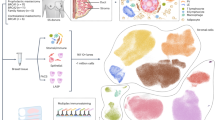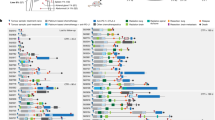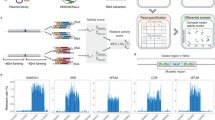Abstract
We performed genome-wide sequencing and analyzed mRNA and miRNA expression, DNA copy number, and DNA methylation in 117 Wilms tumors, followed by targeted sequencing of 651 Wilms tumors. In addition to genes previously implicated in Wilms tumors (WT1, CTNNB1, AMER1, DROSHA, DGCR8, XPO5, DICER1, SIX1, SIX2, MLLT1, MYCN, and TP53), we identified mutations in genes not previously recognized as recurrently involved in Wilms tumors, the most frequent being BCOR, BCORL1, NONO, MAX, COL6A3, ASXL1, MAP3K4, and ARID1A. DNA copy number changes resulted in recurrent 1q gain, MYCN amplification, LIN28B gain, and MIRLET7A loss. Unexpected germline variants involved PALB2 and CHEK2. Integrated analyses support two major classes of genetic changes that preserve the progenitor state and/or interrupt normal development.
This is a preview of subscription content, access via your institution
Access options
Access Nature and 54 other Nature Portfolio journals
Get Nature+, our best-value online-access subscription
$29.99 / 30 days
cancel any time
Subscribe to this journal
Receive 12 print issues and online access
$209.00 per year
only $17.42 per issue
Buy this article
- Purchase on Springer Link
- Instant access to full article PDF
Prices may be subject to local taxes which are calculated during checkout


Similar content being viewed by others
Accession codes
References
Gadd, S. et al. Clinically relevant subsets identified by gene expression patterns support a revised ontogenic model of Wilms tumor: a Children's Oncology Group Study. Neoplasia 14, 742–756 (2012).
Torrezan, G.T. et al. Recurrent somatic mutation in DROSHA induces microRNA profile changes in Wilms tumour. Nat. Commun. 5, 4039 (2014).
Wegert, J. et al. Mutations in the SIX1/2 pathway and the DROSHA/DGCR8 miRNA microprocessor complex underlie high-risk blastemal type Wilms tumors. Cancer Cell 27, 298–311 (2015).
Rakheja, D. et al. Somatic mutations in DROSHA and DICER1 impair microRNA biogenesis through distinct mechanisms in Wilms tumours. Nat. Commun. 2, 4802 (2014).
Beckwith, J.B. & Palmer, N.F. Histopathology and prognosis of Wilms tumors: results from the First National Wilms' Tumor Study. Cancer 41, 1937–1948 (1978).
Walz, A.L. et al. Recurrent DGCR8, DROSHA, and SIX homeodomain mutations in favorable histology Wilms tumors. Cancer Cell 27, 286–297 (2015).
Perlman, E.J. et al. MLLT1 YEATS domain mutations in clinically distinctive favourable histology Wilms tumours. Nat. Commun. 6, 10013 (2015).
Ooms, A.H.A.G. et al. Significance of TP53 mutation in Wilms tumors with diffuse anaplasia: a report from the Children's Oncology Group. Clin. Cancer Res. 22, 5582–5591 (2016).
Astuti, D. et al. Germline mutations in DIS3L2 cause the Perlman syndrome of overgrowth and Wilms tumor susceptibility. Nat. Genet. 44, 277–284 (2012).
Maschietto, M. et al. TP53 mutational status is a potential marker for risk stratification in Wilms tumour with diffuse anaplasia. PLoS One 9, e109924 (2014).
Maiti, S., Alam, R., Amos, C.I. & Huff, V. Frequent association of β-catenin and WT1 mutations in Wilms tumors. Cancer Res. 60, 6288–6292 (2000).
Wu, M.K. et al. Biallelic DICER1 mutations occur in Wilms tumours. J. Pathol. 230, 154–164 (2013).
Palculict, T.B. et al. Identification of germline DICER1 mutations and loss of heterozygosity in familial Wilms tumour. J. Med. Genet. 53, 385–388 (2016).
Foulkes, W.D. et al. Extending the phenotypes associated with DICER1 mutations. Hum. Mutat. 32, 1381–1384 (2011).
Hill, D.A. et al. DICER1 mutations in familial pleuropulmonary blastoma. Science 325, 965 (2009).
Heravi-Moussavi, A. et al. Recurrent somatic DICER1 mutations in nonepithelial ovarian cancers. N. Engl. J. Med. 366, 234–242 (2012).
Passon, D.M. et al. Structure of the heterodimer of human NONO and paraspeckle protein component 1 and analysis of its role in subnuclear body formation. Proc. Natl. Acad. Sci. USA 109, 4846–4850 (2012).
Gratias, E.J. et al. Association of chromosome 1q gain with inferior survival in favorable-histology Wilms tumor: a report from the Children's Oncology Group. J. Clin. Oncol. 34, 3189–3194 (2016).
Chagtai, T. et al. Gain of 1q as a prognostic biomarker in Wilms tumors (WTs) treated with preoperative chemotherapy in the International Society of Paediatric Oncology (SIOP) WT 2001 Trial: a SIOP Renal Tumours Biology Consortium study. J. Clin. Oncol. 34, 3195–3203 (2016).
Williams, R.D. et al. Multiple mechanisms of MYCN dysregulation in Wilms tumour. Oncotarget 6, 7232–7243 (2015).
Kort, E.J. et al. The E2F3–Oncomir-1 axis is activated in Wilms' tumor. Cancer Res. 68, 4034–4038 (2008).
Cai, W.Y. et al. The Wnt–β-catenin pathway represses let-7 microRNA expression through transactivation of Lin28 to augment breast cancer stem cell expansion. J. Cell Sci. 126, 2877–2889 (2013).
Tsialikas, J. & Romer-Seibert, J. LIN28: roles and regulation in development and beyond. Development 142, 2397–2404 (2015).
Maschietto, M. et al. The IGF signalling pathway in Wilms tumours—a report from the ENCCA Renal Tumours Biology-driven drug development workshop. Oncotarget 5, 8014–8026 (2014).
Tehler, D., Høyland-Kroghsbo, N.M. & Lund, A.H. The miR-10 microRNA precursor family. RNA Biol. 8, 728–734 (2011).
Mechtler, P. et al. The evidence for a microRNA product of human DROSHA gene. RNA Biol. http://dx.doi.org/10.1080/15476286.2017.1342934 (2017).
Johanson, T.M., Lew, A.M. & Chong, M.M. MicroRNA-independent roles of the RNase III enzymes Drosha and Dicer. Open Biol. 3, 130144 (2013).
Lee, D., Nam, J.W. & Shin, C. DROSHA targets its own transcript to modulate alternative splicing. RNA 23, 1035–1047 (2017).
Xu, J., Liu, H., Park, J.S., Lan, Y. & Jiang, R. Osr1 acts downstream of and interacts synergistically with Six2 to maintain nephron progenitor cells during kidney organogenesis. Development 141, 1442–1452 (2014).
Kobayashi, A. et al. Six2 defines and regulates a multipotent self-renewing nephron progenitor population throughout mammalian kidney development. Cell Stem Cell 3, 169–181 (2008).
Adli, M., Parlak, M., Li, Y. & El-Dahr, S.S. Epigenetic states of nephron progenitors and epithelial differentiation. J. Cell Biochem. 116, 893–902 (2015).
Dutta, R., Tiu, B. & Sakamoto, K.M. CBP/p300 acetyltransferase activity in hematologic malignancies. Mol. Genet. Metab. 119, 37–43 (2016).
Essafi, A. et al. A Wt1-controlled chromatin switching mechanism underpins tissue-specific Wnt4 activation and repression. Dev. Cell 21, 559–574 (2011).
Shao, Y. et al. Reversible histone acetylation involved in transcriptional regulation of WT1 gene. Acta Biochim. Biophys. Sin. (Shanghai) 39, 931–938 (2007).
Dekel, B. et al. Multiple imprinted and stemness genes provide a link between normal and tumor progenitor cells of the developing human kidney. Cancer Res. 66, 6040–6049 (2006).
Harari-Steinberg, O. et al. Identification of human nephron progenitors capable of generation of kidney structures and functional repair of chronic renal disease. EMBO Mol. Med. 5, 1556–1568 (2013).
Pode-Shakked, N. et al. Dissecting stages of human kidney development and tumorigenesis with surface markers affords simple prospective purification of nephron stem cells. Sci. Rep. 6, 23562 (2016).
Self, M. et al. Six2 is required for suppression of nephrogenesis and progenitor renewal in the developing kidney. EMBO J. 25, 5214–5228 (2006).
Mugrauer, G., Alt, F.W. & Ekblom, P. N-myc proto-oncogene expression during organogenesis in the developing mouse as revealed by in situ hybridization. J. Cell Biol. 107, 1325–1335 (1988).
Laurenti, E., Wilson, A. & Trumpp, A. Myc's other life: stem cells and beyond. Curr. Opin. Cell Biol. 21, 844–854 (2009).
Xu, J. et al. Eya1 interacts with Six2 and Myc to regulate expansion of the nephron progenitor pool during nephrogenesis. Dev. Cell 31, 434–447 (2014).
Grandori, C., Cowley, S.M., James, L.P. & Eisenman, R.N. The Myc/Max/Mad network and the transcriptional control of cell behavior. Annu. Rev. Cell Dev. Biol. 16, 653–699 (2000).
Liu, P.Y. et al. Effects of a novel long noncoding RNA, lncUSMycN, on N-Myc expression and neuroblastoma progression. J. Natl. Cancer Inst. 106, dju113 (2014).
Urbach, A. et al. Lin28 sustains early renal progenitors and induces Wilms tumor. Genes Dev. 28, 971–982 (2014).
Viswanathan, S.R. et al. Lin28 promotes transformation and is associated with advanced human malignancies. Nat. Genet. 41, 843–848 (2009).
He, N. et al. Human polymerase-associated factor complex (PAFc) connects the super elongation complex (SEC) to RNA polymerase II on chromatin. Proc. Natl. Acad. Sci. USA 108, E636–E645 (2011).
Abell, A.N. et al. MAP3K4/CBP-regulated H2B acetylation controls epithelial–mesenchymal transition in trophoblast stem cells. Cell Stem Cell 8, 525–537 (2011).
Kaeser, M.D., Aslanian, A., Dong, M.Q., Yates, J.R. III & Emerson, B.M. BRD7, a novel PBAF-specific SWI/SNF subunit, is required for target gene activation and repression in embryonic stem cells. J. Biol. Chem. 283, 32254–32263 (2008).
Sun, H. et al. Solution structure of BRD7 bromodomain and its interaction with acetylated peptides from histone H3 and H4. Biochem. Biophys. Res. Commun. 358, 435–441 (2007).
Li, Y. et al. AF9 YEATS domain links histone acetylation to DOT1L-mediated H3K79 methylation. Cell 159, 558–571 (2014).
Srinivasan, R.S., de Erkenez, A.C. & Hemenway, C.S. The mixed lineage leukemia fusion partner AF9 binds specific isoforms of the BCL-6 corepressor. Oncogene 22, 3395–3406 (2003).
Fan, Z. et al. BCOR regulates mesenchymal stem cell function by epigenetic mechanisms. Nat. Cell Biol. 11, 1002–1009 (2009).
Park, J.S., Valerius, M.T. & McMahon, A.P. Wnt/β-catenin signaling regulates nephron induction during mouse kidney development. Development 134, 2533–2539 (2007).
Schmidt-Ott, K.M. et al. β-catenin/TCF/Lef controls a differentiation-associated transcriptional program in renal epithelial progenitors. Development 134, 3177–3190 (2007).
Major, M.B. et al. Wilms tumor suppressor WTX negatively regulates WNT/β-catenin signaling. Science 316, 1043–1046 (2007).
Williams, R.D. et al. Subtype-specific FBXW7 mutation and MYCN copy number gain in Wilms' tumor. Clin. Cancer Res. 16, 2036–2045 (2010).
Beckwith, J.B., Zuppan, C.E., Browning, N.G., Moksness, J. & Breslow, N.E. Histological analysis of aggressiveness and responsiveness in Wilms' tumor. Med. Pediatr. Oncol. 27, 422–428 (1996).
Reid, S. et al. Biallelic mutations in PALB2 cause Fanconi anemia subtype FA-N and predispose to childhood cancer. Nat. Genet. 39, 162–164 (2007).
Rayner, T.F. et al. A simple spreadsheet-based, MIAME-supportive format for microarray data: MAGE-TAB. BMC Bioinformatics 7, 489 (2006).
Drmanac, R. et al. Human genome sequencing using unchained base reads on self-assembling DNA nanoarrays. Science 327, 78–81 (2010).
Bainbridge, M.N. et al. De novo truncating mutations in ASXL3 are associated with a novel clinical phenotype with similarities to Bohring–Opitz syndrome. Genome Med. 5, 11 (2013).
Lupski, J.R. et al. Exome sequencing resolves apparent incidental findings and reveals further complexity of SH3TC2 variant alleles causing Charcot–Marie–Tooth neuropathy. Genome Med. 5, 57–70 (2013).
Edmonson, M.N. et al. Bambino: a variant detector and alignment viewer for next-generation sequencing data in the SAM/BAM format. Bioinformatics 27, 865–866 (2011).
McLaren, W. et al. Deriving the consequences of genomic variants with the Ensembl API and SNP Effect Predictor. Bioinformatics 26, 2069–2070 (2010).
Adzhubei, I.A. et al. A method and server for predicting damaging missense mutations. Nat. Methods 7, 248–249 (2010).
Liu, X., Jian, X. & Boerwinkle, E. dbNSFP: a lightweight database of human nonsynonymous SNPs and their functional predictions. Hum. Mutat. 32, 894–899 (2011).
Schwarz, J.M., Cooper, D.N., Schuelke, M. & Seelow, D. MutationTaster2: mutation prediction for the deep-sequencing age. Nat. Methods 11, 361–362 (2014).
Reva, B., Antipin, Y. & Sander, C. Predicting the functional impact of protein mutations: application to cancer genomics. Nucleic Acids Res. 39, e118 (2011).
Choi, Y., Sims, G.E., Murphy, S., Miller, J.R. & Chan, A.P. Predicting the functional effect of amino acid substitutions and indels. PLoS One 7, e46688 (2012).
Chun, H.J. et al. Genome-wide profiles of extra-cranial malignant rhabdoid tumors reveal heterogeneity and dysregulated developmental pathways. Cancer Cell 29, 394–406 (2016).
Cingolani, P. et al. Using Drosophila melanogaster as a model for genotoxic chemical mutational studies with a new program, SnpSift. Front. Genet. 3, 35 (2012).
Cingolani, P. et al. A program for annotating and predicting the effects of single nucleotide polymorphisms, SnpEff: SNPs in the genome of Drosophila melanogaster strain w1118; iso-2; iso-3. Fly (Austin) 6, 80–92 (2012).
Futreal, P.A. et al. A census of human cancer genes. Nat. Rev. Cancer 4, 177–183 (2004).
Brunskill, E.W. et al. Atlas of gene expression in the developing kidney at microanatomic resolution. Dev. Cell 15, 781–791 (2008).
Li, H. & Durbin, R. Fast and accurate short read alignment with Burrows–Wheeler transform. Bioinformatics 25, 1754–1760 (2009).
Subramanian, A. et al. Gene set enrichment analysis: a knowledge-based approach for interpreting genome-wide expression profiles. Proc. Natl. Acad. Sci. USA 102, 15545–15550 (2005).
Brunet, J.P., Tamayo, P., Golub, T.R. & Mesirov, J.P. Metagenes and molecular pattern discovery using matrix factorization. Proc. Natl. Acad. Sci. USA 101, 4164–4169 (2004).
Gooskens, S.L. et al. TCF21 hypermethylation in genetically quiescent clear cell sarcoma of the kidney. Oncotarget 6, 15828–15841 (2015).
Arnold, K., Bordoli, L., Kopp, J. & Schwede, T. The SWISS-MODEL workspace: a web-based environment for protein structure homology modelling. Bioinformatics 22, 195–201 (2006).
Acknowledgements
The authors thank the Clinical Applications of Core Technology Laboratory of the Hartwell Center for Bioinformatics and Biotechnology of St. Jude Children's Research Hospital for performing the copy number analysis, and the Northwestern University Genomic Core facility for performing the methylation analysis. The authors are grateful for the expertise of K. Novik, L. Monovich, P. Beezhold, D. Kersey, D. Turner, M. McNulty, and Y. Moyer. This work would not be possible without the dedication of the experts within the many clinical disciplines at local institutions and within the Children's Oncology Group and National Wilms Tumor Study Group, the patients, and their families. The TARGET initiative is supported by US National Cancer Institute (NCI) grant U10 CA98543. Work performed under contracts from the NCI within HHSN261200800001E includes specimen processing (the COG Biopathology Center), WGS (CGI, Inc.), whole-exome sequencing (Baylor College of Medicine), miRNA-seq, RNA-seq, and target capture sequencing (BCCA Genome Sciences Center). Financial support was provided by TARGET U10 CA98543 contract HHSN261200800001E and National Institutes of Health (NIH) grants U10CA180886, NIH U10CA180899, NIH U10CA098413, and NIH U10CA42326 (E.J.P.); U10CA98543 (J.S.D., E.J.P.); U24 CA114766 and UO1CA88131 (E.J.P.), and NCI T32 CA079447 (A.L.W., A.E.A.). This work is also supported by the American and Lebanese Syrian Associated Charities of St. Jude (J.M., C.G.M.), the King Abdullah University of Science and Technology (S.T.A.), and the Dutch Cancer Society (A.H.A.G.O.). The content of this publication does not necessarily reflect the views or policies of the US Department of Health and Human Services, nor does the mention of trade names, commercial products, or organizations imply endorsement by the US Government.
Author information
Authors and Affiliations
Contributions
D.S.G., J.M.G.A., M.A.S., P.G., L.C.H., and T.D. oversaw the administrative and data management aspects of the TARGET project. D.M., C.H.H., C.N., C.Y., Q.-R.C., and Y.H. performed the bioinformatic analysis. S.T.A. performed the in silico protein structure analysis. J.M.G.-F. and N.R. performed the specimen processing and quality control. J.S.D. and V.H. provided the samples and clinical data. C.G.M. and J.M. performed the copy number analysis through level 1. S.G. performed the level 4 analyses of all platforms and wrote the paper with contributions from all other authors. A.L.W. performed the miRNA analysis. A.E.A. performed the level 3 and 4 copy number analysis. A.H.A.G.O. performed the TP53 analysis. Y.M., Z.Z., A.J.M., R.A.M., and M.A.M. performed the target capture sequencing and mRNA sequencing. D.A.W. and O.A.H. performed the whole-exome sequencing. E.J.P. designed and oversaw all aspects of the study.
Corresponding author
Ethics declarations
Competing interests
The authors declare no competing financial interests.
Supplementary information
Supplementary Text and Figures
Supplementary Figures 1–4 (PDF 1400 kb)
Supplementary Table 1
Discovery set verified COSMIC mutations, nonsense, and frameshift mutations and verified somatic missense and in-frame variants predicted to be damaging and not identified in 1000 Genomes series 3. (XLSX 212 kb)
Supplementary Table 2
Verified high-quality somatic structural variants identified in 80 samples anaylzed by whole-genome sequencing. (XLSX 24 kb)
Supplementary Table 3
Details of variants detected by target capture sequencing and predicted to be damaging within the validation set. (XLSX 241 kb)
Supplementary Table 4
Distribution by histology and concurrent mutations identified in validation set. (XLSX 14 kb)
Supplementary Table 5
Segmental DNA copy changes (>8 probes with segment log2 mean below –0.5 or above 0.5). (XLSX 1403 kb)
Supplementary Table 6
GSEA Hallmark and positional gene sets significantly enriched (FDR < 20%, and P < 5% in each NMF gene expression cluster). (XLSX 12 kb)
Supplementary Table 7
Genes with >5 localized, coordinately differentially methylated probes (q < 0.05 and FC either >1.5 or <0.5). (XLSX 19 kb)
Rights and permissions
About this article
Cite this article
Gadd, S., Huff, V., Walz, A. et al. A Children's Oncology Group and TARGET initiative exploring the genetic landscape of Wilms tumor. Nat Genet 49, 1487–1494 (2017). https://doi.org/10.1038/ng.3940
Received:
Accepted:
Published:
Issue Date:
DOI: https://doi.org/10.1038/ng.3940
This article is cited by
-
Cancer predisposition signaling in Beckwith-Wiedemann Syndrome drives Wilms tumor development
British Journal of Cancer (2024)
-
The evolutionary impact of childhood cancer on the human gene pool
Nature Communications (2024)
-
MAP3K4 kinase action and dual role in cancer
Discover Oncology (2024)
-
Hallmark discoveries in the biology of Wilms tumour
Nature Reviews Urology (2024)
-
Targeting TRIP13 in favorable histology Wilms tumor with nuclear export inhibitors synergizes with doxorubicin
Communications Biology (2024)



